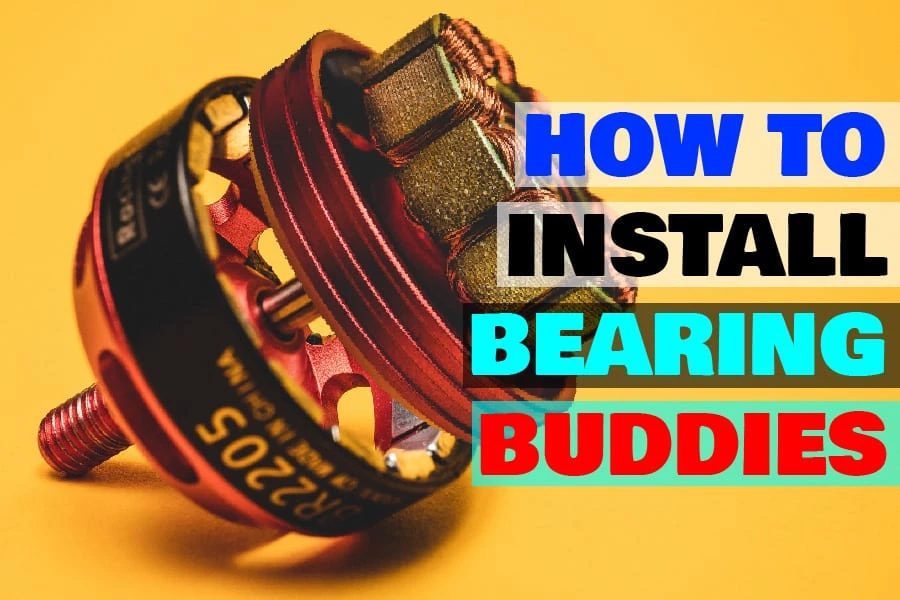When it comes to bearing protectors, bearing buddies specialize in trailers. These bearing caps are designed for high humid conditions. They keep the dust and moisture away from the bearings.
They are a common fixture for water transportation or automobiles used near water bodies. Moisture accumulation in bearings is detrimental to their function. Eventually, they cause rust and wear and tear.
Fortunately, Bearing Buddies makes it easy and convenient to protect them. They are not complicated to install.
With a little skill, you will have them installed within an hour. This article explores the steps of installing Bearing Buddies.
How to Install Bearing Buddies
To install Bearing Buddies, remove the old don’t caps using a screwdriver. In this case, the flatbed is the best option as it can get between the cap and bearing.
Make sure you wipe the bearings and replace any damaged ones. Next, install the Bearing Buddies using a rubber hammer. Pump grease into the bearings and seal with rubber bearing buddies covers.
Bearing Buddies Installing Steps
1. Uninstall Old Dust Caps
- It’s crucial to know the size of the caps you’ll need before starting any process. Ill-fitting Bearing Buddies will not help your cause. Buy the right size.
Note that the serial number of Bearing Buddies corresponds with the diameter if you add a decimal after the first number. If the serial number is 1790, then the diameter is 1.790 inches.
Bearing Buddies comes in two options: chrome or steel. Choose steel for areas known for salty water.
- With the help of a flatbed screwdriver and hammer, pry off the old caps. Bearing Buddies have ‘weeping holes,’ which allow excess grease to drain. You wouldn’t miss it.
Between the cap and the bearing, place the screwdriver. Using a hammer, slam the back of the flatbed. Slowly pry the circular ends apart to remove the cap.
- Removing the caps can be a tricky affair, especially if you do not take your time and attempt to yank it off in one try.
Hit the screwdriver into the caps edges all around until it loosens from the bearing. On rare occasions, screwdrivers do not work. In this case, specialized cap pliers get the job done.
- Once the cap is off, use a piece of cloth to clean the dust and dirty lubricant from the plate. That will make it easy to inspect for damages and parts that need replacement.
- If there are any damages, replace the broken parts. The ultimate goal is to protect the bearing and its inner parts.
Once Bearing Buddies are in place, it will keep the dust and moisture out. It is preventing damages caused by the two.
2. Installing Bearing Buddies
- Align the Bearing Buddies to the bearing tube. The hollow side or the Bearing Buddies tube should face the bearings while the narrow opening should be outside.
Use a rubber hammer for the installation process. Gently hammer the Bearing Buddies round the bearing unwillingly is firmly in place.
- Remember hammers are recommended because they will not cause damages to the Bearing Buddies. However, if it is not available, you can use a normal hammer over a small piece of a wooden plank.
- Once the Bearing Buddies are in place, use a lubricant gun to fill the bearing with grease. The grease helps the parts move efficiently and prevents wear and tear. Bearing Buddies have ‘weeping holes,’ which allow excess grease to drain.
- Bearing Buddies comes with rubber covers that secure the bearings and keep dust and moisture out. That prevents damage to the bearings. After greasing, place the rubber to cover them.
Place it over the narrow entrance of the metal cap. Push it in gently until firmly in place. The entire process is reasonably easy if the steps are followed.
It would be best if you always replaced broken or damaged bearings. Do not replace bearing caps over damaged parts.
Benefits Of Bearing Buddies
Bearing Buddies is not just like any other bearing cap. It is designed to function better and save you from checking and replacing bearings. Here are some of the advantages of this bearing protector.
- It keeps water and dust away from the bearings. Water seeping into the hubs will damage the bearings and reduce functionality.
Bearing Buddies keep the grease level stable by tightly sealing the bearing in. Water and dust will not be able to enter.
- They are easy to install. Bearing Buddies are easy to install. If you purchase the right size for your bearings, nothing can go wrong.
- This bearing protector has an overflow feature that prevents grease from overfilling.
Where To Use Bearing Buddies
Although it is a functional tool, Bearing Buddies is designed for specific vehicles. You cannot fit it onto some bearings won’t is ideal to do research. They recommend it for RVs, trailers, and boats.
It is also a fitting addition to vehicles exposed to water frequently, such as snow automobiles.
Types Of Bearings
Bearings are crucial in moving parts of vehicles and machinery. That is why it is very important to keep them in good working conditions by installing Bearing Buddies.
Regardless, it’s critical to understand the bearing in question. Below is a list of common bearings today.
Ball bearings
One of the most popular types of bearings is ball bearings. It features several rounds, moving parts sandwiched between two ring-like metal structures. The metal structures called races work so that the inner one moves while the outer one does not.
The advantage of such a system is the low friction on the moving parts. That means minimal wear and tear and long-lasting bearings. They are also pocket-friendly and simple to replace.
Unfortunately, ball bearings cannot bear much weight due to the small contact area. They are also very loud while operational.
Angular Contact
Such a type of bearing is designed to handle larger loads. They have contact angles and inner and outer races like the ball bearings. That gives it a greater capacity to handle the huge one-direction axial and radial loads.
Angular Contact bearings are specifically designed for heavy load vehicles. These include agricultural trucks and so on.
Thrust Ball
Two races and a rolling ball component make up a thrust ball bearing. Between the races, there’s a rolling ball component.
Due to their composition, thrust ball bearings are best for axial loads rather than radial loads. They are certainly great in high-speed operations due to the minimal friction, which results in little abrasion.
Rolling Element
They are meant to minimize friction and resistance as they function like ball bearings. Unlike ball bearings, they don’t use balls rather cylindrical components.
This design makes it the best option for the significant radial load. A modified design with different patterns other than cylinders will greatly reduce friction, thus supporting more radial and axial load.
Self-aligning Ball Bearings
This bearing has two rows of balls encased in a circular metal race. The inner ring has two deep grooves on the outer side of the inner ring.
Such bearings are immune to misalignment. It can easily rearrange itself to counter the misalignment.
There are other types of bearings, but these are the most popular in most operating machinery. It is best to regularly protect bearings, especially those exposed to water and dust. Bearing Buddies can be used on vehicles and boats.
Tips For Bearing Care
To maintain healthy bearing functionality, you need to take some precautions. Proper maintenance ensures the bearing doesn’t get damaged and the machine works as well as it is supposed to. Here are some tips to help.
Always Lubricate
That is nothing new. Bearings function well if they are always lubricated regularly. However, there is more to lubrication than just greasing and oiling.
Using the right type of lubricant will extend the life of your bearings. But using incorrect lubricants will damage the bearing and reduce functionality. Always consult with the manufacturers if you are not sure.
Do not miss different lubricants. These lubricants come in different viscosity and will not mix nor work together as they should. Again, ask if you are not sure.
Overloading
Bearings are made in a variety of ways to accommodate various loads. If they are overloaded, then the life expectancy will reduce drastically. In some cases, the bearing may break completely, rendering it useless.
Always watch out for warning signs that the bearing is overloaded. Unusual noises, high temperature, and slow-moving parts might be tell-tale signs. Make sure you use the right bearing for the right load. That will save you time and money.
Conclusion
Bearing health is key for the moving parts of all motor vehicles and machines. Although they will eventually succumb to what and tear, extending their functionality with proper practices is best.
Bearing Buddies ensure that your boats and RVs are working in good condition for a long time to come. Remember, before working on your vehicle or boat, check your warranty and any other important document. If you can fix it with minimal damage, do it. Otherwise, visit a professional.







